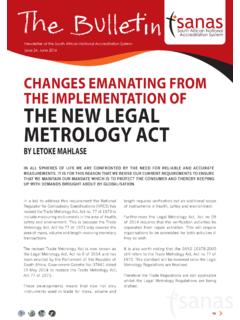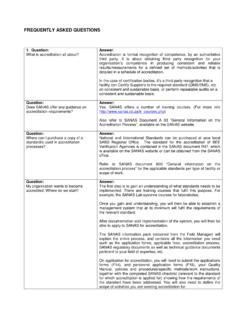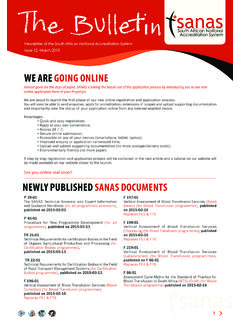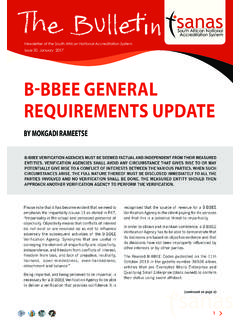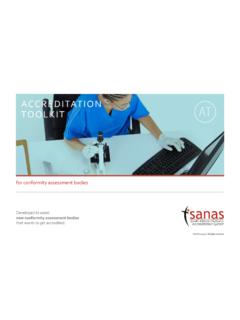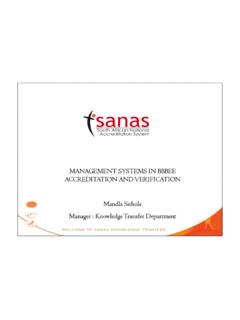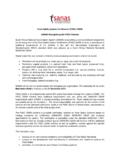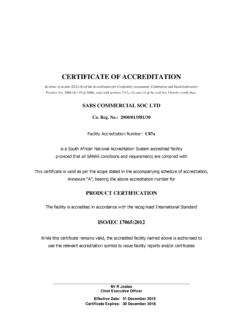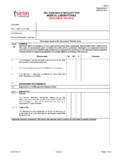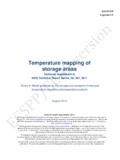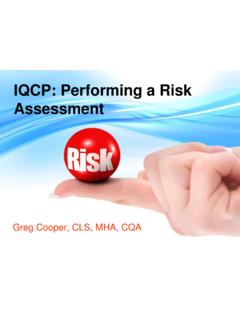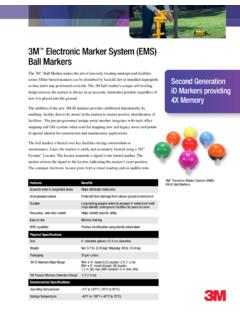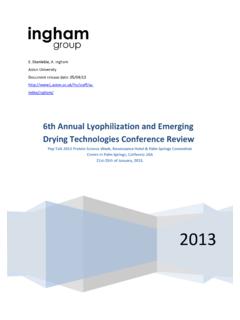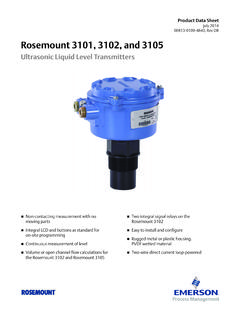Transcription of RISK MANAGEMENT FOR MEDICAL LABORATORIES
1 RISK MANAGEMENT FOR MEDICAL LABORATORIESBY TATI KUBHEKAINTRODUCTION In the delivery of quality patient care, a clinical laboratory prides itself on performing extensive, effective, and documented quality control (QC), giving healthcare professionals confidence that test results obtained on patient specimens are consistently accurate and reliable. By definition, risk is a measure of the severity of the impact of a potential error, multiplied by the probability of how likely it is that the error will occur and the ability to detect the error if it should re - occur. Correspondingly, risk MANAGEMENT is the sequential process of risk identification, risk assessment, and risk mitigation. Simply stated, risk MANAGEMENT includes: Risk identification: identifying potential sources of error; Risk assessment: evaluating errors to determine their impact on patient test results; and Risk mitigation: controlling errors in such a way that residual risk is IDENTIFICATIONRisk identification is the first and perhaps the most important step in the risk MANAGEMENT process.
2 Correctly identifying potential sources of error for a particular test reveals valuable information Newsletter of the South African National Accreditation SystemIssue 25, July 2016 1 WHY RISK MANAGEMENT ? Risk MANAGEMENT is a requirement of ISO 15189:2012To ensure LABORATORIES understand the concept of risk MANAGEMENT The laboratory shall evaluate the impact of work processes and potential failures on examination results as they affect patient safety, and shall modify processes to reduce or eliminate the identified risks and document decisions and actions taken. Risk analysis, assessment and MANAGEMENT is not new to the clinical LABORATORIES . FORMAL risk analysis, assessment and MANAGEMENT is NEW. 2for developing an individualized quality control plan. Identifying the potential risks embedded in laboratory testing processes allows for the implementation of an overarching quality control plan that effectively mitigates errors not addressed by the test system s internal quality checks and external quality 1.
3 A process map showing key steps in the clinical diagnostic testing decisions and effective treatment planning are dependent on laboratory results. Therefore, it is important to understand that in performing an effective risk assessment, one size does not fit all! Every diagnostic test carries varied risks and may require varied control measures. Accurate risk identification is essential when developing and implementing a comprehensive and effective individualized quality control are several tools available to help laboratory staff perform risk identification. The most effective tool will vary from laboratory to laboratory. Therefore, it is important that all options are considered, and that the most effective tool is selected that will positively impact the uniqueness of each laboratory. The following are examples: Process mapping: A process map is a graphical representation of all the steps in a testing process.
4 This tool is used to analyze a particular testing process by breaking it down into small steps from start to finish (see Figure 1). Fishbone diagram: A fishbone diagram outlines the cause and effect of a testing process. It may be considered to be a graphical representation of all the major elements in a process. This diagram can help labs identify and organize potential errors in a test system (see Figure 2). Risk identification table: A risk identification table is a simple table that lists all the errors identified in the different testing phases for a specific test (see Table 1).Regardless of the tool selected, it is important to consider all phases of sample testing: the preanalytic, analytic, and postanalytic phases. The key objectives in implementing an effective risk MANAGEMENT process and, hence, an IQC Plan, are identifying the potential errors in all phases of testing, and ensuring optimal mitigation by putting in place effective and documented obtained in performing the risk assessment will be used to develop an IQC Plan.
5 This plan will serve to describe QC practices, resources, and procedures that will be used to monitor and ensure continued quality laboratory testing. As with all laboratory procedures, the laboratory director remains ultimately responsible for the proper development and implementation of each IQC Plan. The laboratory director is required to approve and sign each IQC Plan before it is ASSESSMENTA lthough the goal for all healthcare professionals is to optimize the delivery of quality patient care, error rates are evident and distributed among the three phases of testing: preanalytic, analytic, and example, studies have shown that 46% to of lab errors occur during the preanalytic phase. Such errors may include, but are not limited to, inappropriate test requests, order entry errors, misidentification of patients, utilization of improper containers, inadequate sample collection and transport procedures, inadequate sample/anticoagulant volume ratio, insufficient sample volume, sorting and routing errors, and labeling contrast, roughly 7% to 13% of lab errors occur during the analytic phase.
6 Such errors may include, but are not limited to, equipment malfunction, sample mix interference, undetected failure in quality control, and incorrect testing finally, to 47% of errors occur in the postanalytic phase. Such errors may include, but are not limited to, failure in reporting, erroneous validation of analytical data, and improper data entry and MANAGEMENT FOR MEDICAL LABORATORIES (continued)3 From these examples, one can conclude that greater emphasis has traditionally been placed on risk identification and risk mitigation for the analytic phase of testing versus the preanalytic and postanalytic phases. However, the high error rates apparent in the preanalytic and postanalytic phases demonstrate precisely the need for risk MANAGEMENT in all phases of testing. Risk MANAGEMENT is an all-inclusive quality MANAGEMENT process that guides the laboratory staff to evaluate potential risks in all phases of testing, which is the essence of IQC PhaseAnalytical PhasePostanalytical PhaseSpecimenSample quantity insufficientInterfering substancesClotted specimenPersonnelLack of technical or phlebotomy trainingCompetency assessment not peformed in past 2 yearsInadequate training in how to report critical value resultsLab EnvironmentHeavy traffic in speciment receiving areaFluctuating temperatresTest SystemsCalibration overdueTst system lacks mechanism for error detectionElementPreanalytical PhaseAnalytical PhasePostanalytical PhaseReagentsLack of inventory controlImproper reagent mixingPostanalytic Activities__LIS not verfied after recent updateTable 1.
7 A risk identification table enables laboratory staff to identify sources of error in each of the five major areas of diagnostic testing, and to further divide errors according to the phase of testing in which they performing a risk MANAGEMENT process and, hence, evaluating the entire testing process, it is important to consider the following key areas within the five components of the diagnostic process that affect the quality patient test results: environment, testing personnel, specimen, testing process, and doing so, how the test is performed, how often relevant errors or undesirable conditions occur, the potential impact of those errors, what control activities are in place to detect or prevent those errors, how the test is used by the physician, patient population, and volume RISK MANAGEMENT FOR MEDICAL LABORATORIES (continued) Incorrect Test Result1 Samples2 Operator3 Reagents5 Measuring System4 Laboratory EnvironmentSample IntegritySample Presentation- Lipemia- Hemolysis- Interfering subtances- Clotting- Incorrect tube- Bubbles- Inadequate volumeOperator CapacityOperator staffingAtmospheric EnvironmentUtility Environment- Training- Competency- Short staffing- Correct staffing- Dust- Temperature- Humidity- Electrical- Water quality- PressureReagent Degradation- Shipping- Storage- Used past expiration- PreparationQuality Control Material Degradation- Shipping- Storage- Used past expiration- PreparationCalibrator Degradation- Shipping- Storage- Used past expiration- Preparation Instrument FailureInadequate Instrument Maintenance- Software failure- Optics drift- Electronic instability- Dirty optics- Contamination- ScratchesIdentify Potential HazardsFigure 2.
8 A fishbone diagram showing potential sources of error associated with five major components of the diagnostic testing testing can all be considered in developing the risk assessment. The following sections offer some key examples of risk assessment considerations in each of the five Areas of importance that require focus include the following: Where is testing performed, and what other activities occur nearby? Are room temperature and humidity stable? Are testing areas level, and draft- and vibration-free? Does altitude affect the testing? Have lighting, electricity, water quality, and other utilities been considered?Testing Personnel. Individuals performing testing must be evaluated to ensure that their training and competency assessment records can be used to validate the qualifications of testing personnel to accurately perform testing. Key questions to be addressed in this area include the following: Do testing personnel have laboratory medicine education and experience?
9 Have testing personnel been adequately trained to perform the test? Have competency assessments been performed on testing personnel?Although testing personnel may have been trained to perform specific types of testing, it cannot be assumed that all testing personnel maintain the superior level of performance they initially demonstrated. It is therefore essential that competency assessments be performed on a continuing Ensuring the collection of the right specimen from the right patient is essential. Review specimen collection, handling, and storage procedures. Review all instructions that are provided to patients regarding preparation for the self-collection of is important to ensure that all specimens are handled and stored appropriately, and are suitable for Process. It is important to gather information regarding the measuring system, the instrument, or other test device. Varied types of information can contribute to risk assessment in this area.
10 For commercialized instruments, tests, and test kits, a great deal of such information is supplied by the manufacturer through a package insert or operator s manual. A test system may have safeguards such as lockout functions and error codes that detect and prevent errors. Laboratory historical data can be considered. Maintenance logs, QA and QC records, verification of performance specifications, and calibration verification records are a few examples of documentation to addition, an assessment of risk should consider the utilization of test results by the ordering physician when developing a treatment plan for the patient. Some test results represent only a portion of the information that contributes to clinical decisions. Others are used immediately, as the sole decision-making criterion. In the latter situation, an inaccurate result has a much greater potential to cause harm, making an understanding of the clinical use of test results an important element for determining the quality control measures a lab needs to Test reagents can be compromised during shipment, handling, storage, and processing.
